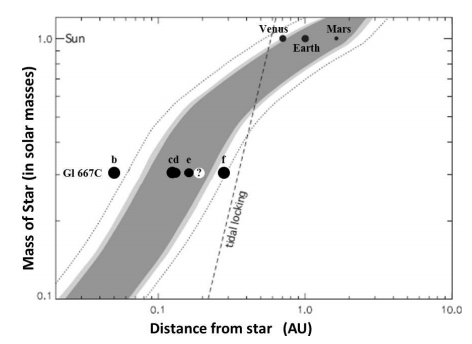Three Habitable Zone Planets Discovered Around One Red Dwarf
A red dwarf that is itself part of a triple star system, hosts three planets in its habitable zone, says astronomer
Gliese 667 is a triple star system about 22 light years from Earth in the constellation of Scorpius. Two of these stars–Gliese 667 A and B–are Sun-like and orbit each other relatively closely.
The third is much more interesting. Gliese 667C a red dwarf that is about a third of the mass of our Sun and only about 1 per cent as bright. It orbits the other two stars at a much greater distance: some 200 astronomical units or about 30 billion kilometres.
Red dwarfs are particularly interesting for astronomers because their small mass makes it much easier to spot orbiting planets. What’s more, their low luminosity means that these stars’ habitable zones are much closer than for brighter stars.
This story is only available to subscribers.
Don’t settle for half the story.
Get paywall-free access to technology news for the here and now.
Subscribe now
Already a subscriber?
Sign in
You’ve read all your free stories.
MIT Technology Review provides an
intelligent and independent filter for the
flood of information about technology.
Subscribe now
Already a subscriber?
Sign in
Since current planet spotting techniques favour closer planets, astronomers know they are much more likely to find planets in the habitable zone around red dwarfs. In fact, today’s news is a good example.
Today, Philip Gregory at the University of British Columbia in Canada says that Gliese 667Chas three planets sitting squarely in the middle of its habitable zone.
Gregory is a pioneer of new statistical techniques for evaluating the data from planet-hunting instruments. “The excitement generated by … many … exoplanetary discoveries has spurred a significant effort to improve the statistical tools for analyzing data in this field,” he says.
So he’s used a new technique to re-examine data on Gliese 667C taken by the High Accuracy Radial velocity Planet Searcher, HARPS, attached the European Southern Observatory’s 3.6 metre telescope in Chile.
He says this analysis indicates that the most likely number of planets around Gliese 667C is 6 with orbital periods of 7 days, 28 days, 31 days, 39 days, 53 days and 91 days. Only two of these were already known.
However, the most interesting news is that the 28, 31 and 39 day-planets are all smack bang in the middle of the habitable zone, he says.
These planets are all larger than Earth but the 39 day period planet (planet e) is only just over twice Earth’s mass. That makes it “the lowest mass planet in the habitable zone detected to date,” says Gregory.
That’s exciting news which will make Gliese 667C the target of significant interest in the near future from astrobiologists wanting to know more about these potentially Earth-like places. And with three to examine around a single star, they will be spoilt for choice.
Ref: arxiv.org/abs/1212.4058: Evidence for Multiple Planets in the Habitable Zone of Gliese 667C: A Bayesian Re-analysis of the HARPS data
